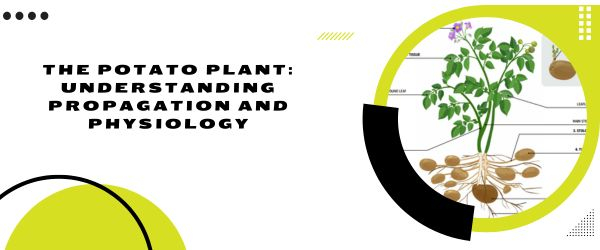#PotatoPlant #Propagation #Physiology #Tubers #SeedPotatoes #Stolons #Sprouts #Roots #Flowers
The propagation of commercial potatoes primarily involves the planting of seed potatoes or seed pieces, which are whole or cut tubers. These seed potatoes contain “eyes” or axial buds, from which new growth emerges. Although the crop initially takes time to emerge, it quickly progresses as it taps into its substantial carbohydrate reserves.
The anatomy of a potato plant growing from a cut seed piece reveals important structures. Let’s explore the key parts of the potato plant:
Stem and Leaf Tissue: Above ground, the stem and leaf tissue of the potato plant form. The leaves grow in a spiral pattern at each node, with the oldest leaves located at the base of the stem and the youngest at the top. Leaves play a vital role in capturing sunlight for energy conversion, while the stems provide support, transport water and nutrients between the roots and leaves, and facilitate the movement of carbohydrates from the leaves to the tubers for storage. This above-ground vegetation is referred to as the haulm, canopy, or vine.

Sprouts: The swelling and subsequent elongation of the eyes result in the formation of sprouts. Sprouts are the first visible signs of crop growth after planting and eventually develop into leafy stems as they emerge above the ground.
Stolons: Stolons are modified underground stems. They can elongate until they reach the soil surface and grow into leafy stems or, under specific management conditions, start to swell, leading to the initiation of new tubers. Stolons begin to form within three weeks of planting and grow horizontally from the sprout nodes.
Tubers: Tubers form at the end of stolons and primarily serve as storage organs for carbohydrates produced by the plant’s photosynthesizing leaves. Young tubers, known as tuberization, typically occur when the plants reach a height of 15 to 20 cm, approximately 5 to 7 weeks after planting. Tubers have two ends: the proximal end (stem end) where the tuber attaches to the stolon and the distal end (bud end) where the youngest cells and the highest number of eyes are found. Tubers are covered by skin tissue (periderm), which contains small pores called lenticels. These protective structures safeguard the developing tuber from stress and pathogens while allowing gas exchange with the soil. Tubers grown in waterlogged soils often exhibit enlarged lenticels, reducing their resistance to pathogen attacks.
Seed Pieces: Seed pieces for potato propagation should ideally range from 55 to 80 grams in size. They can be whole tubers or cut pieces, but they must have at least one sprouting eye. Seed dressings are commonly applied to protect against decay and disease development.
Roots: Roots can emerge both from the nodes of elongating sprouts above the seed piece and from the seed piece itself. The potato plant has a relatively shallow (<30 cm) and sparse root system, which necessitates careful consideration for water and nutrient management.
Apart from these structures, the potato plant also exhibits elongated petioles with a single terminal leaflet at their ends, followed by a row of opposing leaflets. Flowers, known as inflorescence, may appear once the plant has formed 10 to 13 leaves. The color of the flowers can vary, including white, blue, purple, pink, or red. Flowering is variety-dependent and may be influenced by stress. Notably, tuberization can occur independently of flowering, allowing the formation of new tubers even in the absence of flowers.
Understanding the propagation and physiology of the potato plant enables farmers and researchers to optimize cultivation techniques and enhance crop yields. By selecting appropriate seed potatoes, managing water and nutrient supply, and monitoring plant stress, farmers can promote healthy tuber development. Additionally, knowledge of the potato plant’s anatomy and growth stages assists in disease prevention and allows for timely intervention in case of any issues.
By delving into the intricacies of the potato plant, we can appreciate the remarkable journey from seed potatoes to fully grown tubers, ensuring a steady supply of this versatile and essential crop.








